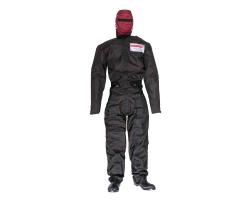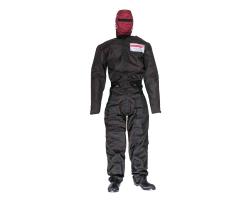Ruth Lee Manikin Inspection and Maintenance Guide

I.C. Brindle Inspection and Maintenance Guide for Ruth Lee Manikins
As a proud and dedicated distributor of Ruth Lee Manikins, we are thrilled to present our comprehensive equipment guide, crafted from the official Ruth Lee Maintenance & Inspection Routine.
Our collaboration with Ruth Lee allows us to bring this exceptional range of rescue and training manikins to the public, available for purchase through our website at competitive prices.
Inspection of Manikin: Before and After Use
To ensure optimal performance and safety during training and rescue scenarios with Ruth Lee manikins, it's crucial to conduct thorough visual inspections. Here's a detailed checklist to follow:
- Examine the manikins for any tears or holes that may impede their handling, ensuring they're free from any damage that could compromise their functionality during training exercises.
- Inspect the seams of the manikins to ensure they remain intact and securely stitched. It's essential to check for signs of wear and tear on the stitching, as well as any areas where seams may have become un-stitched, to maintain the structural integrity of the training manikins.
- Carefully inspect the body of the manikins to ensure nothing has become embedded within them. Foreign objects lodged in the manikins could pose risks during use of manikins during training drills and rescue excercises, so it's important to thoroughly check for any obstructions.
- Check the limbs of the manikins to ensure they are securely attached and not loose. Additionally, verify that no parts of the manikins are at risk of detachment during manikin training drills, as this could potentially cause safety hazards.
By following these guidelines and conducting regular visual inspections, you can ensure the continued effectiveness and safety of Ruth Lee training and rescue manikins during training exercises and rescue simulations.
Cleaning and Storing Ruth Lee Manikins
Ruth Lee training and rescue manikins are crafted from durable, waterproof polyester material, ensuring longevity and ease of maintenance. This polyester fabric not only withstands rigorous training sessions but also enables effective cleaning and decontamination processes, crucial for maintaining hygiene standards.
The protective overalls featured on these manikins are designed for convenience. These can be removed, allowing for thorough cleaning after each use. The training manikin overalls are also machine washable at a temperature of 40°C, providing a simple and effective method for keeping them clean and ready for the next training session. It's important to note that tumble drying should be avoided to prevent any potential damage to the protective overalls.
With these features and benefits of Ruth Lee manikinns, they offer both durability and practicality, so ensuring they remain in optimal condition for repeated training and rescue scenarios is essential!
Here are the instructions for cleaning and maintaining Ruth Lee training and rescue manikins:
- If the manikin becomes soiled, simply wipe it down with a solution of soapy water. After cleaning, hang the manikin up to dry. This straightforward process effectively removes dirt and debris, ensuring the manikin is ready for future use.
- In the event that the manikin is soiled with oil or similar substances, it's essential to take extra care during cleaning. Use a suitable cleaning fluid to carefully remove the oil, ensuring it's thoroughly cleaned before washing with soapy water to eliminate any remaining residue. Avoid using bleach or caustic-based cleaning fluids, as these can compromise the integrity of the fabric over time.
- If the manikin becomes wet during use or cleaning, promptly hang it up to dry in a well-ventilated area. Thanks to the training manikin quick-drying properties, the rescue training manikins should dry rapidly, minimising downtime between training sessions.
- Despite being constructed from tough, waterproof polyester, it's crucial to ensure the manikin is completely dry before stowing it away. This precaution helps maintain the fabric's integrity and prevents any potential damage that could occur if moisture is trapped within the manikin during storage.
By following these cleaning and drying guidelines, you can prolong the lifespan of your Ruth Lee manikins and ensure it remains in optimal condition for continued manikin training and rescue activities.
Decontamination of Training Manikins
In the event that the manikin has been exposed to hazardous substances during an exercise, it is imperative to include it in the decontamination process alongside other equipment. If the manikin has absorbed any of the substances, it's crucial to seek specific instructions from the Hazmat Office for proper handling and decontamination procedures.
These specialised instructions will ensure the safe and effective removal of hazardous materials from the training manikin, mitigating any potential risks associated with exposure. Prioritising the safety of both responders and trainees—following these guidelines is essential for maintaining a secure training environment.
Caring and Maintaining your Ruth Lee Manikin
Handle Ruth Lee training manikins with care and respect, treating them as you would a volunteer casualty. Avoid deliberately dropping or abusing the manikins to ensure their longevity and effectiveness during training sessions.
Additionally, refrain from exposing Ruth Lee manikins to fire, excessive heat, or hazardous substances. In case of contamination, it's crucial to decontaminate the manikin before further handling.
By following these guidelines, you can maintain the integrity of Ruth Lee training manikins and ensure safe and realistic training experiences well into the future. Saving you both money and time, but also upholding a culture of safety.
What if my Training Manikin is Damaged?
If you find that your Ruth Lee training manikin has sustained damage, it's essential to address the issue promptly. While Ruth lee manikins are constructed from robust and resilient materials, regular usage in training scenarios can naturally lead to wear and tear over time.
Following the previous steps above will help you to prolong the life of your ruth lee manikin training equipment.
I.C. Brindle also has a range of Ruth Lee training products to help ensure that your Ruth Lee manikins are kept in top shape, such as the wellington boots, training manikin overalls, and training manikin drag protectors.
Additional Information Regarding Water Rescue Manikins:
Ruth Lee training manikins for water rescue are specifically engineered to permit water ingress during use, facilitating realistic training scenarios. It's advisable to ensure proper drainage by allowing any accumulated water to drain out after each use.
To speed up this process effectively, Ruth Lee recommends hanging the manikins using the prominently featured large webbing loop at the back. Additionally, removing the wellington boots can aid in drainage and help maintain the integrity of the manikins for extended use in training exercises.
Training Manikin Might Contain Metal Components
Please be aware that the Ruth Lee training manikins may contain metal components in their construction, such as zippers or metal ballast used to attain the necessary weight. If metal content is a concern for you, please reach out to us before making a purchase, and we'll be happy to address any questions or provide alternative options.
Hygiene and PPE Requirements (Post-Covid19 Precautions):
During the global COVID-19 pandemic, it was essential to implement extra precautions for hygiene and safety during and after all training sessions, in addition to your standard personal protective equipment (PPE) requirements.
It's crucial to remember that even beyond the COVID-19 pandemic, contagious diseases and pathogens remain a concern. Therefore, it remains imperative to adhere to these hygiene requirements for your Ruth Lee manikins to ensure ongoing safety and prevent the spread of illnesses.
Given the susceptibility of Ruth Lee manikins' polyester fabric to degradation when exposed to bleach or chlorine-based products, it's important to avoid using such harsh chemicals for cleaning. Instead, we recommend utilizing hot, soapy water to thoroughly wash the manikins at the conclusion of each training session, ensuring they are hung up to dry completely afterward.
During training sessions, consider employing bleach-free multi-surface cleaners or wipes, like Dettol surface cleanser, to wipe down the manikins between participants. This approach can effectively minimise the risk of cross-contamination.
Depending on the nature of the training scenario, it may also be advisable to use gloves and masks for added protection.
Additionally, remember that the manikin overalls and pyjamas worn by the manikins are machine washable. It's recommended to wash them between each training session to maintain cleanliness and hygiene standards.



























